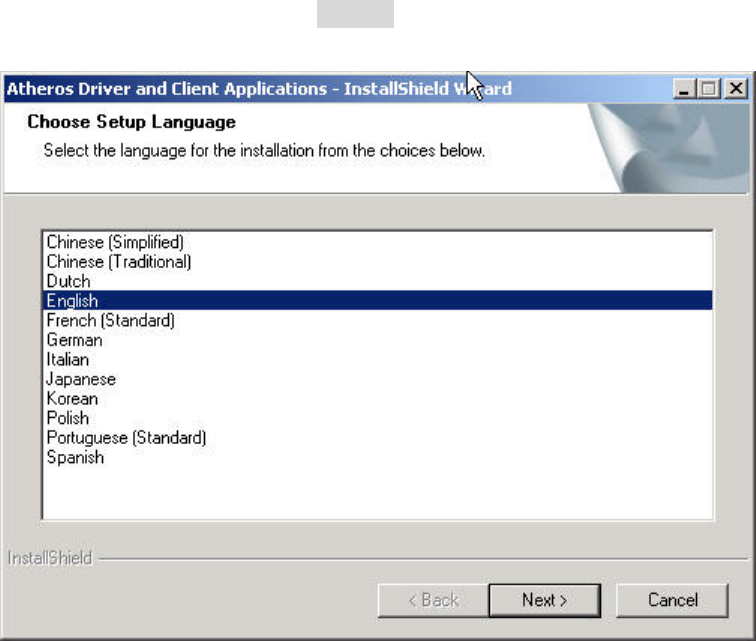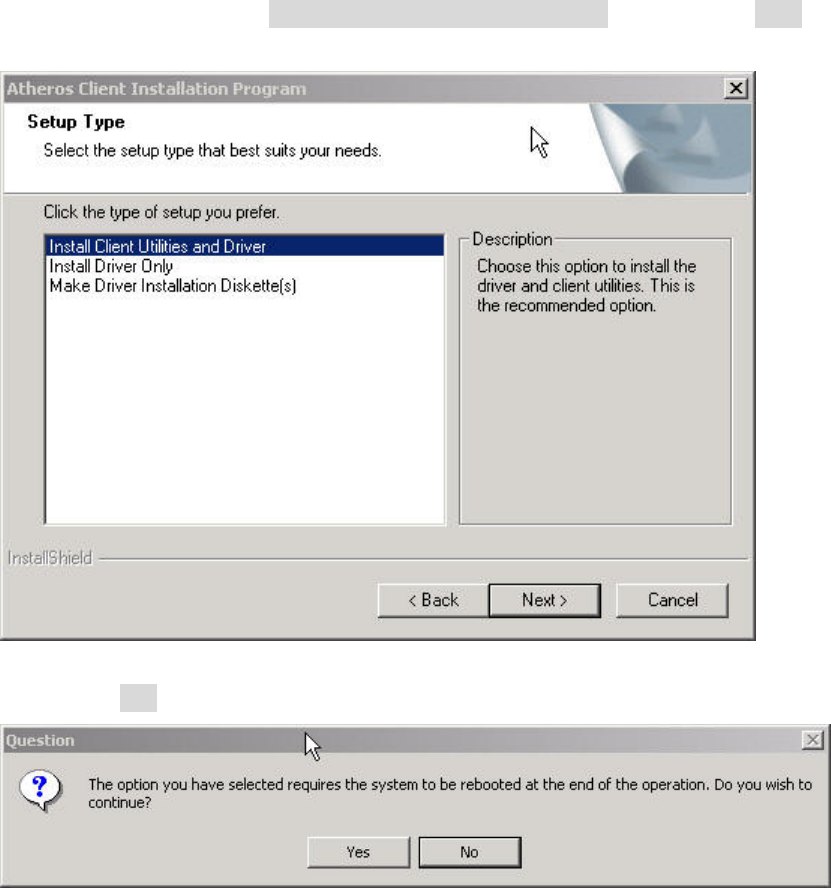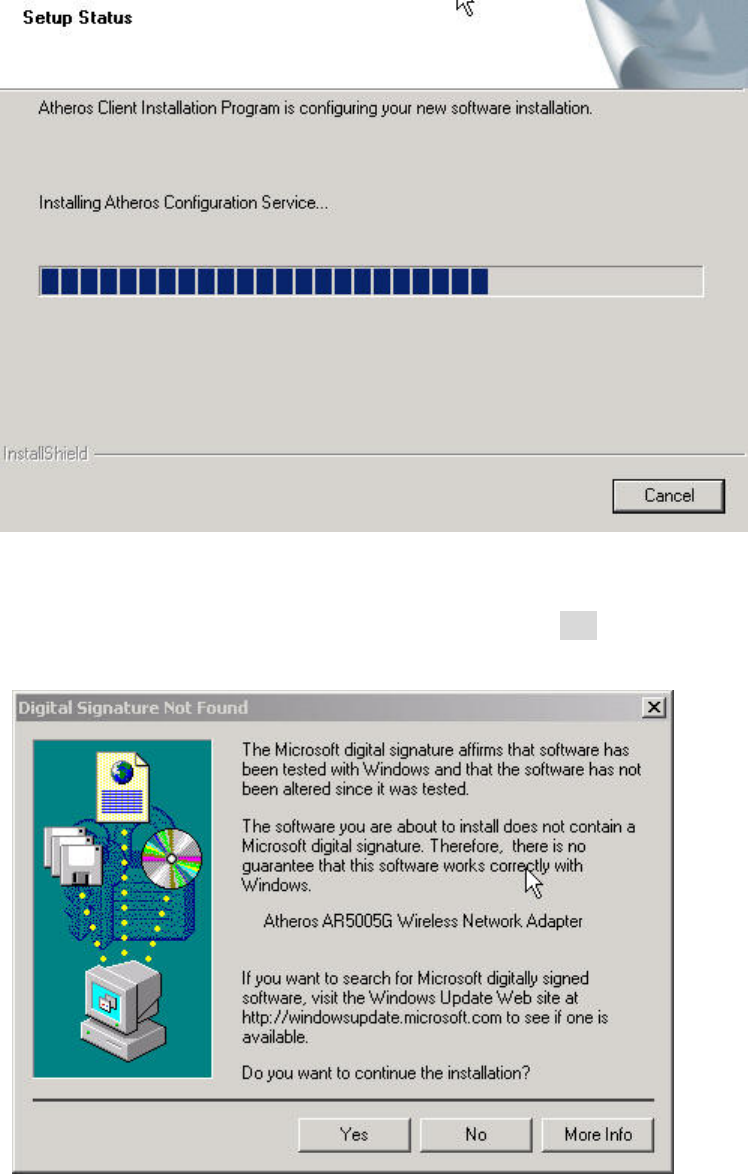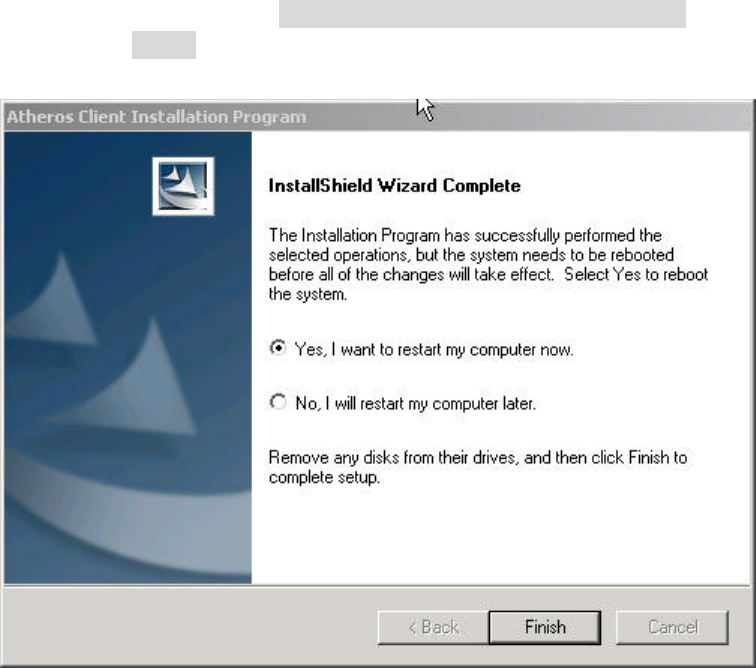Actiontec Electronics 802MAG MiniPCI Atheros 802.11b/g WLAN Card User Manual 802MAG
Actiontec Electronics Inc MiniPCI Atheros 802.11b/g WLAN Card 802MAG
Manual
MiniPCI 802.11b/g
Wireless Card
802MAG
User’s Manual
Contents
1. Contents
2. Introduction
3. Bluetooth Basics
4. Installation Overview
5. Federal Communication Commission Interface Statement
6. Statement
2. Introduction
Thank you for purchasing MiniPCI 802.11b/g wireless lan Module. This manual will
assist you with the installation procedure.
The package you have received should contain the following items:
• Mini PCI 802.11b/g Wireless LAN Card
• User manual
• CD containing Wireless LAN Management utility and driver software.
Note: if anything is missing, please contact your vendor
3. MiniPCI 802.11b/g Wireless Lan Card Basics
Wireless systems offer a great number of advantages over a traditional, wired system.
MiniPCI Wireless LAN Card are more flexible, easier to setup and manage and often
more cost effective than their wired equivalence.
With Mini PCI wireless LAN Card users can access shared information without
looking for a place to plug in and network managers can set up or augment networks
without installing or moving wires. MiniPCI Wireless LAN Card offers the following
productivity, convenience and cost advantages over traditional wired networks.
• Mobility – Wireless systems can provide LAN users with access to real-time
information anywhere in their organization. This mobility supports
productivity and service opportunities not possible with wired
networks.
• Installation Speed and Simplicity – Installing a MiniPCI Wireless LAN Card system
can be fast and easy and can eliminate the need to pull cable through
walls and ceilings.
• Installation Flexibility – wireless technology allows the network to go where wires
cannot go.
• Reduced Cost-of-Ownership – While the initial investment required for MiniPCI
Wireless LAN Card hardware might be higher than the cost of wired
LAN hardware, overall installation expenses and life-cycle costs will
be significantly lower. Long- term cost benefits are greatest in dynamic
environments requiring frequent moves, adds, and changes.
• Scalability – MiniPCI Wireless LAN Card systems can be configured in a variety of
topologies to meet the needs of specific applications and installations.
Configurations are easily changed and range from peer-to-peer
networks suitable for a small number of users to full infrastructure
networks of thousands of users that allows roaming over a broad area.

4. Installation and Overview
Here are some steps you will perform in establishing your wireless network
connection:
1. Install Atheros Utility using the Installation CD.
2. The Installshield Wizard will showed up
3. Please choose the language in English

4. The “Atheros Client Installation Program” will show up, please click Next.
.
5. Please click I accept the terms of the license agreement. Then click Next

6. Recommended you to click Install Client Utilities and Driver and then click Next
7. Please click Yes to continue.

8. Please click Browse to find the Atheros driver destination location. And then
click Next
9. Please click OK to continue

10. Wait, while Setup is performing the request operations.
11. “ Digital Signature Not Found” will appear, please click Yes to continue

12. Recommend you to choose Yes, I want to restart my computer now
Please click Finish to complete the installation

13. If you install the driver successfully. The Atheros Icon will be showed up.
14. You could double click the Atheros Icon to check the Signal Strength.
Federal Communication Commission Interference Statement
This equipment has been tested and found to comply with the limits for
a Class B digital device, pursuant to Part 15 of the FCC Rules. These
limits are designed to provide reasonable protection against harmful
interference in a residential installation. This equipment generates, uses
and can radiate radio frequency energy and, if not installed and used in
accordance with the instructions, may cause harmful interference to
radio communications. However, there is no guarantee that
interference will not occur in a particular installation. If this equipment
does cause harmful interference to radio or television reception, which
can be determined by turning the equipment off and on, the user is
encouraged to try to correct the interference by one of the following
measures:
- Reorient or relocate the receiving antenna.
- Increase the separation between the equipment and receiver.
- Connect the equipment into an outlet on a circuit different from that
to which the receiver is connected.
- Consult the dealer or an experienced radio/TV technician for help.
FCC Caution: Any changes or modifications not expressly approved by
the party responsible for compliance could void the user's authority to
operate this equipment.
This device complies with Part 15 of the FCC Rules. Operation is
subject to the following two conditions: (1) This device may not cause
harmful interference, and (2) this device must accept any interference
received, including interference that may cause undesired operation.
IMPORTANT NOTE:
FCC Radiation Exposure Statement:
This equipment complies with FCC radiation exposure limits set forth for
an uncontrolled environment. This equipment should be installed and
operated with minimum distance 20cm between the radiator & your body.
This transmitter must not be co-located or operating in conjunction with
any other antenna or transmitter.
Statement
Actiontec declares that US model of 802MAG, ( FCC ID: LNQ802MAG ) is
limited in CH1~CH11 for 2.4 G band by specific firmware controlled by the
manufacturer and is not user changeable.
Federal Communication Commission Interference Statement
This equipment has been tested and found to comply with the limits for a Class B
digital device, pursuant to Part 15 of the FCC Rules. These limits are designed to
provide reasonable protection against harmful interference in a residential installation.
This equipment generates, uses and can radiate radio frequency energy and, if not
installed and used in accordance with the instructions, may cause harmful
interference to radio communications. However, there is no guarantee that
interference will not occur in a particular installation. If this equipment does cause
harmful interference to radio or television reception, which can be determined by
turning the equipment off and on, the user is encouraged to try to correct the
interference by one of the following measures:
- Reorient or relocate the receiving antenna.
- Increase the separation between the equipment and receiver.
- Connect the equipment into an outlet on a circuit different from that
to which the receiver is connected.
- Consult the dealer or an experienced radio/TV technician for help.
FCC Caution: Any changes or modifications not expressly approved by the party
responsible for compliance could void the user's authority to operate this equipment.
IMPORTANT NOTE:
FCC Radiation Exposure Statement:
This equipment complies with FCC radiation exposure limits set forth for an
uncontrolled environment. This equipment should be installed and operated with
minimum distance 20cm between the radiator & your body.
This transmitter must not be co-located or operating in conjunction with any other
antenna or transmitter.
IEEE 802.11b or 802.11g operation of this product in the U.S.A. is firmware-limited to
channels 1 through 11.

This device is intended only for OEM integrators under the following
conditions:
1) The antenna must be installed such that 20 cm is maintained between the
antenna and users, and
2) The transmitter module may not be co-located with any other transmitter or
antenna,
3) For all products market in US, OEM has to limit the operation channels in CH1
to CH11 for 2.4G band by supplied firmware programming tool. OEM shall not
supply any tool or info to the end-user regarding to Regulatory Domain change.
As long as 3 conditions above are met, further transmitter test will not be required.
However, the OEM integrator is still responsible for testing their end-product for any
additional compliance requirements required with this module installed (for example,
Broadband Home Router, etc.).
IMPORTANT NOTE: In the event that these conditions can not be met (for example
certain laptop configurations or co-location with another transmitter), then the FCC
authorization is no longer considered valid and the FCC ID can not be used on the
final product. In these circumstances, the OEM integrator will be responsible for
re-evaluating the end product (including the transmitter) and obtaining a separate
FCC authorization.
End Product Labeling
This transmitter module is authorized only for use in device where the antenna may
be installed such that 20 cm may be maintained between the antenna and users. The
final end product must be labeled in a visible area with the following: “Contains FCC
ID: LNQ802MAG”.
Manual Information To the End User
The OEM integrator has to be aware not to provide information to the end user
regarding how to install or remove this RF module in the user’s manual of the end
product which integrates this module.
The end user manual shall include all required regulatory information/warning as show
in this manual.